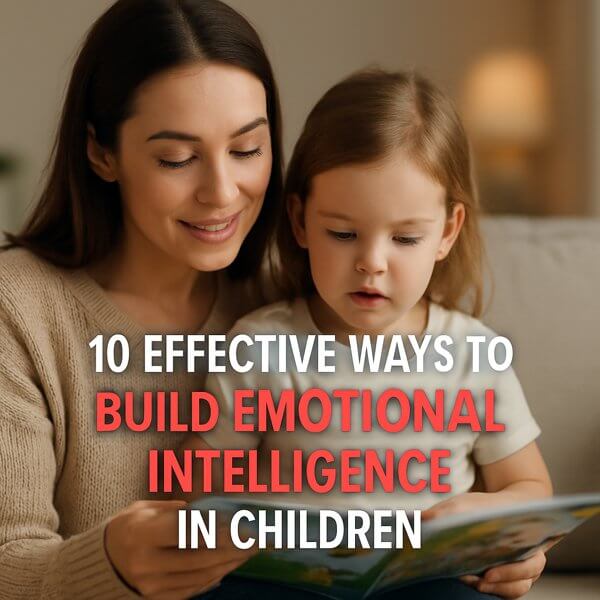10 Effective Ways to Build Emotional Intelligence in Children
Emotional intelligence is important for children. It helps them understand their own feelings and the feelings of others. This skill can improve their relationships, help them make friends, and succeed in school. There are many ways to develop emotional intelligence in kids. In this article, we will explore 10 effective ways to build emotional intelligence in children. Each method is easy to understand and can be used at home or in school. Let’s dive into these strategies!

1. Teach Kids About Emotions Early On
Teaching emotional intelligence in early childhood is crucial. Children need to learn about different emotions as they grow. Start by naming emotions when they arise.
- Use simple words like happy, sad, angry, and scared.
- Show pictures of faces expressing different emotions.
- Ask your child how they feel in various situations.
- Share your own feelings to model emotional expression.
- Read books that talk about feelings and emotions.
When kids recognize emotions, they can better understand themselves and others. This foundation is key to developing emotional intelligence.
For example, when a child sees someone upset, you can ask, “How do you think they feel?” This encourages empathy.
Using an emotional intelligence for kids PDF can also provide helpful resources. These materials often include activities and games focused on emotions.
Overall, teaching kids about emotions sets the stage for deeper emotional understanding later in life.

2. Encourage Open Conversations About Feelings
Talking about feelings is important for kids. Create a safe space where they can express themselves. Ask open-ended questions to get them talking.
- “What made you happy today?”
- “Why were you upset earlier?”
- “How did you handle that situation?”
- “What can we do next time you feel this way?”
- “Who makes you feel good when you’re sad?”
These conversations help kids articulate their feelings. They learn to express themselves clearly. This practice strengthens emotional intelligence in children.
For example, if a child shares that they felt left out at school, discuss ways to cope with those feelings. This builds resilience.
Moreover, regular discussions about emotions can help children identify patterns in their feelings. They may notice what triggers happiness or sadness.
Encouraging open dialogue fosters trust between parents and children. It shows kids that their feelings matter.

3. Model Emotional Intelligence Yourself
Children learn by watching adults. If you want to teach emotional intelligence to a child, demonstrate it yourself. Show them how to handle emotions effectively.
- Express your feelings openly and appropriately.
- Use “I feel” statements to communicate emotions.
- Stay calm during stressful situations.
- Apologize when necessary to show accountability.
- Discuss your own emotional challenges and solutions.
For instance, if you feel frustrated, explain why. Say something like, “I’m feeling frustrated because I can’t find my keys.” This teaches them to recognize frustration in themselves.
By modeling emotional intelligence, you set a positive example. Kids are likely to imitate your behavior.
This approach not only helps them learn but also strengthens your relationship. Sharing emotions creates closeness.
Remember, nobody is perfect. Showing vulnerability can actually enhance emotional learning.

4. Use Games and Activities to Teach Emotions
Teaching emotional intelligence activities can be fun! Games help kids learn in an engaging way. You can use role-playing, board games, or art projects.
- Play charades using emotion cards.
- Make a feelings chart with stickers for daily emotions.
- Create stories together and discuss characters’ feelings.
- Use puppets to act out different emotional scenarios.
- Incorporate music to express mood through songs.
These activities encourage kids to explore emotions creatively. For example, playing charades helps them recognize body language associated with feelings.
Group activities also promote teamwork and cooperation. Kids learn to navigate social interactions while having fun.
Additionally, many educational resources offer emotional intelligence for kids activities. Look for worksheets and games online.
Combining play with learning makes emotional education enjoyable and memorable.

5. Help Kids Recognize Body Language
Body language is a big part of communication. Teaching kids to read body language can boost their emotional intelligence. Help them connect feelings with physical cues.
- Point out facial expressions in everyday life.
- Discuss gestures and posture related to emotions.
- Watch movies and analyze characters’ body language.
- Practice mirroring emotions with your child.
- Encourage them to express themselves physically.
For example, if someone is crossing their arms, ask your child what they think that means. This helps them make connections between actions and emotions.
Recognizing body language aids in empathy. Kids learn to sense how others feel without words.
Moreover, being aware of their own body language helps kids communicate better. They become more effective in expressing their feelings.
Understanding non-verbal cues is essential in all relationships. It enhances their interactions with peers and adults.

6. Teach Problem-Solving Skills
Problem-solving is linked to emotional intelligence. When kids face challenges, they need to find solutions. Teaching them how to solve problems helps them manage emotions.
- Encourage brainstorming solutions to conflicts.
- Guide them through decision-making processes.
- Discuss consequences of different choices.
- Support them in trying new approaches.
- Celebrate successful problem-solving efforts.
For instance, if two kids argue over a toy, guide them in finding a solution. Ask, “How can we share this toy?”
Teaching problem-solving boosts confidence. Kids learn that they can overcome obstacles.
Additionally, discussing past problems and solutions reinforces learning. Reflecting on experiences helps them grow emotionally.
Problem-solving skills contribute to resilience, making kids better equipped for future challenges.

7. Promote Empathy Through Storytelling
Empathy is a core component of emotional intelligence. Storytelling can be a powerful tool in promoting empathy in children. Share stories that highlight different perspectives.
- Read books featuring diverse characters and experiences.
- Discuss how characters might feel in different situations.
- Encourage kids to relate to characters’ emotions.
- Ask questions about what they would do in similar situations.
- Share personal stories that evoke empathy.
For example, after reading a story, ask, “How do you think the character felt when that happened?” This encourages deeper thinking.
Storytelling allows kids to step into someone else’s shoes. This strengthens their ability to empathize with others.
Moreover, sharing personal experiences fosters connection. Kids see that everyone has struggles.
Empathy is essential for building strong relationships throughout life.

8. Practice Mindfulness and Self-Regulation
Mindfulness helps kids manage their emotions. Teaching mindfulness techniques promotes self-awareness and self-regulation. Simple practices can be incorporated into daily routines.
- Introduce deep breathing exercises.
- Practice meditation or yoga together.
- Encourage journaling about feelings.
- Take mindful walks and observe surroundings.
- Discuss the importance of taking breaks when overwhelmed.
For instance, if a child feels angry, guide them through deep breathing. This helps them calm down and reflect.
Practicing mindfulness nurtures emotional control. Kids learn to pause before reacting.
Additionally, mindfulness can reduce anxiety and stress. Kids who practice regularly often experience improved focus and well-being.
Developing emotional intelligence through mindfulness equips children with lifelong skills.

9. Encourage Positive Social Interactions
Social skills are vital for emotional intelligence. Encourage kids to engage in positive social interactions. Provide opportunities for them to interact with peers.
- Set up playdates or group activities.
- Encourage participation in team sports.
- Teach conflict resolution strategies in social settings.
- Discuss the importance of kindness and respect.
- Help them understand different social cues.
For example, participating in team sports teaches cooperation and teamwork. Kids learn to celebrate each other’s successes.
Positive social interactions build confidence. Kids develop friendships based on mutual respect and understanding.
Moreover, learning to navigate social situations prepares kids for adulthood. These skills are essential in professional environments.

10. Foster Resilience Through Challenges
Resilience is closely linked to emotional intelligence. Teaching kids to face challenges helps them bounce back from setbacks. Encourage them to view failures as learning opportunities.
- Discuss famous people who overcame challenges.
- Encourage persistence in difficult tasks.
- Share personal stories of overcoming obstacles.
- Help them set realistic goals and celebrate achievements.
- Teach them to seek support when needed.
For example, if a child struggles with homework, encourage them to try again and ask for help. This builds determination.
Fostering resilience helps kids cope with stress. They learn that challenges are a part of life.
Ultimately, resilient children are more likely to succeed in various areas of life. They develop a growth mindset that will serve them well.

Conclusion: Key Takeaways for Building Emotional Intelligence
Building emotional intelligence in children is essential for their development. The 10 effective ways discussed in this article provide a comprehensive approach. From teaching emotions early on to fostering resilience, each strategy contributes to emotional growth.
Kids learn to express their feelings, understand others, and navigate social situations. By using games, storytelling, and mindfulness, parents and educators can create engaging learning experiences.
Modeling emotional intelligence and encouraging open conversations further strengthen these skills. Ultimately, developing emotional intelligence equips children for success in life.
Investing time and effort in building emotional intelligence pays off. Children grow into empathetic, resilient, and capable individuals. Remember, emotional intelligence is a lifelong journey, and every small step counts.





